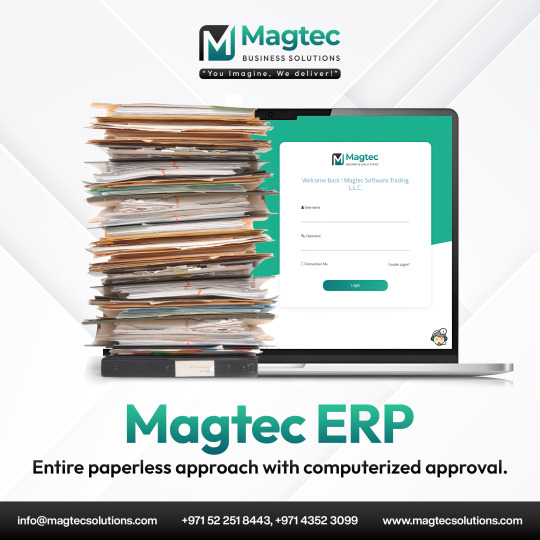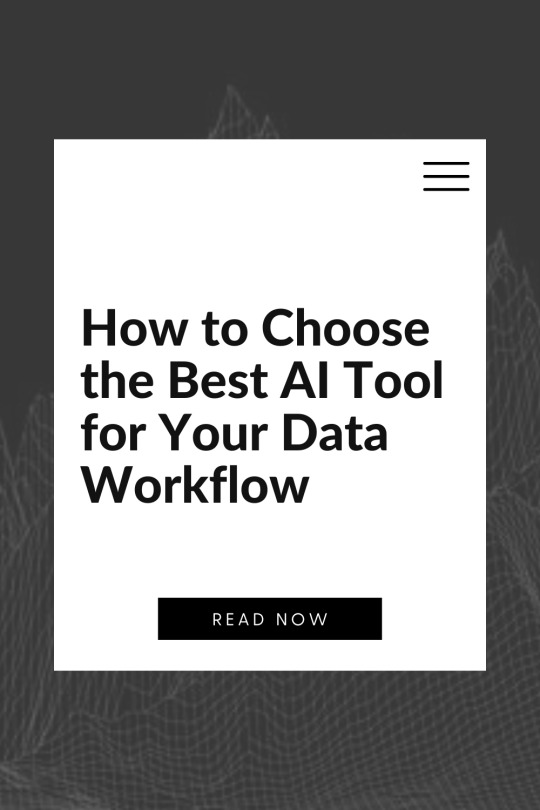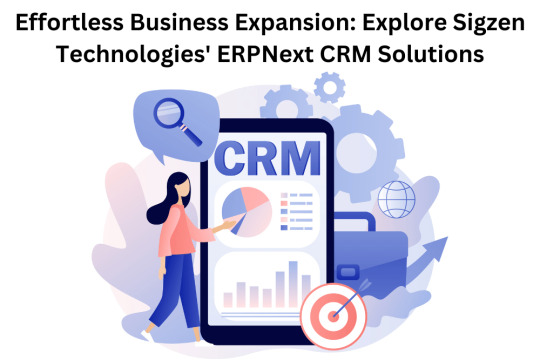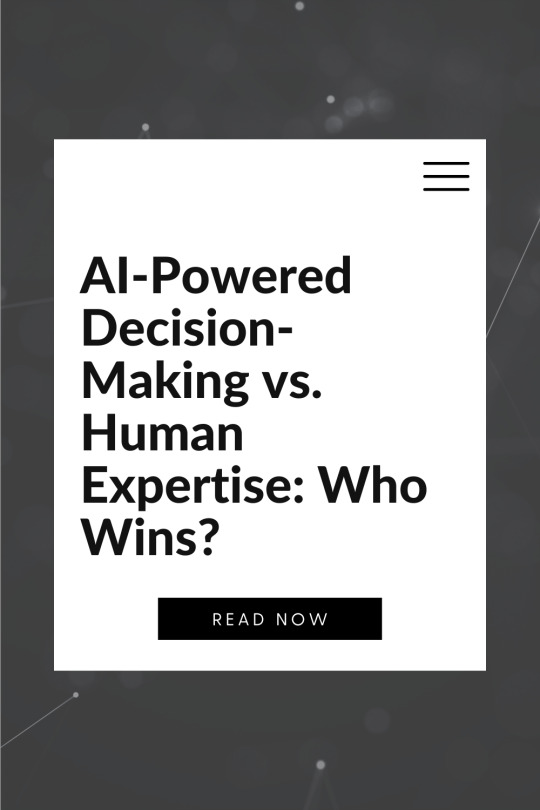#business workflow automation
Explore tagged Tumblr posts
Text
https://tinyurl.com/yck7rvbp
#albato#ai business software#no code platform#business workflow automation#small business owners#business owners#entrepreneurs
0 notes
Text

Magtec ERP: Your one-stop solution for a paperless and efficient business. Say goodbye to piles of paperwork and hello to streamlined approvals!
#magtec#erp#paperless#efficient#business#streamlined#approvals#digitalization#productivity#automation#workflow#solutions#technology#innovation#digitaltransformation#efficiency#documentmanagement#processimprovement#businessmanagement#officeautomation#digitaloffice#smartbusiness#cloudsolution#businesssoftware#workplaceefficiency#digitalrecords#magtecsolutions
2 notes
·
View notes
Text
Get Organized: ERPNext Distribution by Sigzen Makes It Easy
In today’s fast-paced Running a business can be tough, especially when things get messy. But what if there was a way to make it all simpler. That’s where ERPNext Distribution comes in. This awesome tool helps you manage your stuff like inventory, deliveries, and ordering without any hassle. It’s like having a helper for your business tasks. With ERPNext Distribution, you can say goodbye to…

View On WordPress
#Business Automation#ERP Integration#ERP Software Solutions#Inventory Management System#Procurement Management#Resource Planning#Stock Control#Workflow Optimization
2 notes
·
View notes
Text

How to Choose the Best AI Tool for Your Data Workflow
AI isn’t just changing the way we work with data, it’s opening doors to entirely new possibilities. From streamlining everyday tasks to uncovering insights that were once out of reach, the right AI tools can make your data workflow smarter and more efficient. But with so many options out there, finding the one that fits can feel like searching for a needle in a haystack. That’s why taking the time to understand your needs and explore your options isn’t just smart, it’s essential.
In this guide, we’ll walk you through a proven, easy-to-remember decision-making framework: The D.A.T.A. Method: a 4-step process to help you confidently choose the AI tool that fits your workflow, team, and goals.

The D.A.T.A. Method: A Framework for Choosing AI Tools
The D.A.T.A. Method stands for:
Define your goals
Analyze your data needs
Test tools with real scenarios
Assess scalability and fit
Each step provides clarity and focus, helping you navigate a crowded market of AI platforms with confidence.
Step 1: Define Your Goals
Start by identifying the core problem you’re trying to solve. Without a clear purpose, it’s easy to be distracted by tools with impressive features but limited practical value for your needs.
Ask yourself:
What are you hoping to achieve with AI?
Are you focused on automating workflows, building predictive models, generating insights, or something else?
Who are the primary users: data scientists, analysts, or business stakeholders?
What decisions or processes will this tool support?
Having a well-defined objective will help narrow down your choices and align tool functionality with business impact.
Step 2: Analyze Your Data Needs
Different AI tools are designed for different types of data and use cases. Understanding the nature of your data is essential before selecting a platform.
Consider the following:
What types of data are you working with? (Structured, unstructured, text, image, time-series, etc.)
How is your data stored? (Cloud databases, spreadsheets, APIs, third-party platforms)
What is the size and volume of your data?
Do you need real-time processing capabilities, or is batch processing sufficient?
How clean or messy is your data?
For example, if you're analyzing large volumes of unstructured text data, an NLP-focused platform like MonkeyLearn or Hugging Face may be more appropriate than a traditional BI tool.
Step 3: Test Tools with Real Scenarios
Don’t rely solely on vendor claims or product demos. The best way to evaluate an AI tool is by putting it to work in your own environment.
Here’s how:
Use a free trial, sandbox environment, or open-source version of the tool.
Load a representative sample of your data.
Attempt a key task that reflects a typical use case in your workflow.
Assess the output, usability, and speed.
During testing, ask:
Is the setup process straightforward?
How intuitive is the user interface?
Can the tool deliver accurate, actionable results?
How easy is it to collaborate and share results?
This step ensures you're not just selecting a powerful tool, but one that your team can adopt and scale with minimal friction.
Step 4: Assess Scalability and Fit
Choosing a tool that meets your current needs is important, but so is planning for future growth. Consider how well a tool will scale with your team and data volume over time.
Evaluate:
Scalability: Can it handle larger datasets, more complex models, or multiple users?
Integration: Does it connect easily with your existing tech stack and data pipelines?
Collaboration: Can teams work together within the platform effectively?
Support: Is there a responsive support team, active user community, and comprehensive documentation?
Cost: Does the pricing model align with your budget and usage patterns?
A well-fitting AI tool should enhance (not hinder) your existing workflow and strategic roadmap.
“The best tools are the ones that solve real problems, not just the ones with the shiniest features.”
— Ben Lorica (Data scientist and AI conference organizer)
Categories of AI Tools to Explore
To help narrow your search, here’s an overview of AI tool categories commonly used in data workflows:
Data Preparation and Cleaning
Trifacta
Alteryx
DataRobot
Machine Learning Platforms
Google Cloud AI Platform
Azure ML Studio
H2O.ai
Business Intelligence and Visualization
Tableau – Enterprise-grade dashboards and visual analytics.
Power BI – Microsoft’s comprehensive business analytics suite.
ThoughtSpot – Search-driven analytics and natural language querying.
DataPeak by Factr – A next-generation AI assistant that’s ideal for teams looking to enhance decision-making with minimal manual querying.
AI Automation and Workflow Tools
UiPath
Automation Anywhere
Zapier (AI integrations)
Data Integration and ETL
Talend
Fivetran
Apache NiFi
Use the D.A.T.A. Method to determine which combination of these tools best supports your goals, data structure, and team workflows.
AI Tool Selection Checklist
Here’s a practical checklist to guide your evaluation process:
Have you clearly defined your use case and goals?
Do you understand your data’s structure, source, and quality?
Have you tested the tool with a real-world task?
Can the tool scale with your team and data needs?
Is the pricing model sustainable and aligned with your usage?
Does it integrate smoothly into your existing workflow?
Is support readily available?
Selecting the right AI tool is not about chasing the newest technology, it’s about aligning the tool with your specific needs, goals, and data ecosystem. The D.A.T.A. Method offers a simple, repeatable way to bring structure and strategy to your decision-making process.
With a thoughtful approach, you can cut through the noise, avoid common pitfalls, and choose a solution that genuinely enhances your workflow. The perfect AI tool isn’t the one with the most features, it’s the one that fits your needs today and grows with you tomorrow.
Learn more about DataPeak:
#datapeak#factr#saas#technology#agentic ai#artificial intelligence#machine learning#ai#ai-driven business solutions#machine learning for workflow#digitaltools#digital technology#digital trends#datadrivendecisions#dataanalytics#data driven decision making#agentic#ai solutions for data driven decision making#ai business tools#aiinnovation#ai platform for business process automation#ai business solutions
0 notes
Text
How to Use AI as a Brainstorming Tool for Faster, Better Ideas
How to Use AI as a Brainstorming Tool for Faster, Better Ideas Never Start with a Blank Page Again (Seriously) You know that moment, the one where your mind goes blank, your screen’s taunting you with that blinking cursor, and your coffee’s already cold? Yeah, we’ve all been there. But what if I told you that AI can help you skip the mental block and start creating faster? Whether you’re…
#AI automation for entrepreneurs#AI automation for service-based businesses#AI business strategy#AI strategies for business growth#AI tools for solopreneurs#AI workflow optimization#AI-driven content creation for entrepreneurs#AI-powered business coaching#Business Growth#Business Strategy#Entrepreneur#Entrepreneurship#How to implement AI in small business operations#Lori Brooks#Productivity#Small business AI tools#Technology Equality#Time Management
0 notes
Text
AI Automation: Transforming the Future of Work and Business

Artificial Intelligence (AI), a modern powerhouse that is transforming sectors, is no longer a sci-fi idea in the digital age. AI automation, which combines automated procedures with intelligent systems, is one of its most significant uses. This combination is changing how companies function, boosting productivity, cutting expenses, and creating new opportunities in a variety of industries. AI Automation: What Is It? The term "AI automation" describes the process of automating complicated processes that normally call for human intelligence by utilizing artificial intelligence technologies like computer vision, machine learning, and natural language processing. AI automation has the ability to learn, adapt, and make judgments based on data, in contrast to traditional automation, which adheres to predetermined rules and scripts. Examples include:
Customer support, where AI chat bots offer round-the-clock assistance through human-like communication.
Manufacturing: Data-driven intelligent robots modify procedures in real time
Advantages of AI Automation:
1. Enhanced Productivity
AI systems are more efficient than humans at repeated jobs and operate around the clock.
They streamline processes, cutting down on errors and bottlenecks.
2. Savings on expenses
Minimizes the need for big teams to do repetitive activities.
Reduces downtime and enhances the use of resources.
3. Data-Informed Choices
AI analyses enormous datasets to find trends and insights that people would overlook.
Aids in market research and strategic planning.
4. Improved Experience for Customers Personalized suggestions and prompt assistance boost client loyalty and pleasure. 5. Scalability It is simple to grow processes without increasing the staff proportionately. Industries AI is used in
AI Automation in Healthcare: AI helps with administrative, patient monitoring, and diagnostic duties.
Retail: Customer insights, inventory control, and tailored marketing.
Logistics: Demand forecasting, warehouse automation, and route optimisation.
Banking: Algorithmic trading, risk assessment, and customer onboarding.
Human Resources: Performance evaluation, candidate matching, and resume screening.
Upcoming Developments in AI Automation
Hyper automation: End-to-end business automation through the integration of AI with other technologies such as IoT, RPA (Robotic Process Automation), and low-code platforms.
AI programs that are capable of handling complicated jobs on their own, such managing supply chains or negotiating contracts, are known as autonomous agents.
Edge AI: Making choices more quickly and securely by processing data locally on devices rather than in centralized systems.
Explainable AI: Increasing decision-making transparency in AI to increase compliance and confidence.
In conclusion AI automation is not merely a fad; rather, it is a revolutionary force that is changing the way we collaborate, communicate, and create. The benefits are substantial for companies that are prepared to use it: competitive advantage, efficiency, and agility. But for adoption to be effective, the associated social, economic, and ethical issues must also be resolved. One thing is certain as we proceed: AI automation is here to stay, and the future will be dominated by those who can adjust.
Visit: Toolfe for Toolfe Process Automation services and Automate your business
1 note
·
View note
Text
Discover the Best AI Automation Tools for Your Business
Artificial intelligence is revolutionizing the way businesses operate, and choosing the right automation tools is key to unlocking its full potential. According to MIT research, companies that strategically implement AI-driven automation see a significant boost in productivity. For business leaders, the challenge isn’t deciding whether to adopt AI automation tools — it’s determining which tools…
#AI-driven processes#Artificial intelligence tools#Automation technology#Business automation solutions#Machine learning software#Smart business automation#Workflow optimization tools
0 notes
Text
Simplify Client Management with AI
Expedite client book reviews effortlessly with Docyt Copilot, one stop Solution for accounting Assessment and Audit. Start a free trial today!" For more information click here: https://docyt.com/docyt-copilot/
#financial reporting software#expense management software#accounting workflow software#accounts payable automation#accounts payable automation software#accounts payable software for small business#bookkeeping services for business#bookkeeping software for accountants#bookkeeping software for accounting firms#business bookkeeping software#employee expense report#expense management solutions#expense reimbursement report.
0 notes
Text
Unlock Business Efficiency with Project Management and Integration Features

In today’s fast-paced digital world, small businesses need tools that help streamline tasks, enhance team collaboration, and simplify workflows. One such critical tool is project management software that not only organizes projects but also integrates smoothly with other business operations. This is where Commence Corporation delivers real value.
Managing multiple projects with limited resources is a common challenge for small businesses. Without a centralized system, tasks get lost, deadlines slip, and communication gaps widen. The result? Missed opportunities and reduced productivity. That’s why more businesses are investing in smart software solutions that bring together planning, tracking, and collaboration in one efficient platform.
Commence Corporation’s project management solution is designed specifically to address the unique demands of small business environments. From assigning responsibilities to tracking progress and generating reports, the software keeps every team member on the same page. With intuitive dashboards and real-time updates, it ensures that everyone involved has access to the latest information, leading to faster decision-making and improved outcomes.
What sets this platform apart is its integrated project management capabilities. Rather than using separate tools for time tracking, document sharing, or team communication, users benefit from a unified interface. Integration minimizes the need for multiple logins, reduces duplication of work, and provides a complete picture of project status at a glance.
Moreover, the system’s flexibility allows businesses to adapt workflows to their specific operational needs. Whether it’s a marketing campaign, product launch, or service delivery task, the software can be customized for various types of projects and team sizes. Templates, milestones, and automation tools help reduce manual work and accelerate productivity.
Commence Corporation also prioritizes data security and user access control, ensuring sensitive project details remain protected. With cloud-based infrastructure, users can manage and monitor projects from any device, at any time. This level of accessibility is essential for today’s remote and hybrid work models.
Beyond functionality, the software’s integration features also support seamless interaction with popular CRM, accounting, and communication platforms. This fosters a smoother transition between sales and service teams, and ultimately, a better customer experience.
Adopting a robust project management solution is not just a productivity boost—it’s a strategic advantage. By using a solution built with small business needs in mind, teams can focus more on execution and less on coordination.
In conclusion, for businesses aiming to scale efficiently, enhance collaboration, and meet project deadlines consistently, Commence Corporation offers a reliable and forward-thinking project management solution. Designed for small businesses, packed with smart features, and empowered by project management software innovation, it’s the perfect partner in your growth journey.
#project management software#integrated project management#small business project tools#Commence Corporation#workflow automation for small business#business task tracking software#project integration tools
0 notes
Text
Running a small manufacturing biz? You don’t need chaos. You need systems. Try @mrpeasy and bring peace to your process. 👉 https://try.mrpeasy.com/omgitzlo #SponsoredProduct
#Business growth#cloud MRP#ERP#inventory software#manufacturing software#mrpeasy#productivity tools#small business tools#sponsored spotlight#streamline production#workflow automation
0 notes
Text
#n8n io#ai business software#business workflow automation#small business owners#business owners#entrepreneurs
0 notes
Text
Streamlining Business Operations with JDE Orchestrator
Introduction: Brief overview of JD Edwards EnterpriseOne and the role of JDE Orchestrator in modernizing business processes.
Key Features:
Automation of Repetitive Tasks: Discuss how JDE Orchestrator automates routine tasks, reducing manual intervention and errors.
Integration with IoT Devices: Explain the integration capabilities with Internet of Things (IoT) devices for real-time data collection.
API Connectivity: Highlight the ability to connect with third-party applications through APIs.
Benefits:
Enhanced Efficiency: Showcase how automation leads to faster decision-making and reduced operational costs.
Improved Accuracy: Emphasize the reduction in human errors and data inconsistencies.
Scalability: Discuss how businesses can scale operations seamlessly with JDE Orchestrator.
Real-World Applications:
Manufacturing: Example of automating production line processes.
Supply Chain Management: Streamlining inventory management and order processing.
Summarize the transformative impact of JDE Orchestrator on business operations.
Empower your JD Edwards system today by embracing the advanced automation capabilities of jde orchestrator.
#JD Edwards automation#business process orchestration#ERP integration#real-time data processing#IoT-enabled ERP#API-driven workflows.
0 notes
Text
Effortless Business Management: ERPNext CRM Services by Sigzen Technologies
In the dynamic landscape of modern business operations, staying ahead requires more than just hard work – it demands smart solutions. Enter ERPNext CRM, a powerhouse tool designed to streamline business management processes with precision and efficiency. Together, ERPNext CRM paves the way for optimized workflows, enhanced productivity, and unparalleled business growth. So, buckle up as we…

View On WordPress
#business growth#Business Management#Cloud Solutions#CRM#Customer Support#ERP Next#Integrated Solutions#InventoryManagement#Scalable Solutions#Workflow Automation
2 notes
·
View notes
Text

AI-Powered Decision-Making vs. Human Expertise: Who Wins?
Artificial intelligence is already woven into the fabric of our daily lives. Whether you're getting personalized song suggestions on Spotify, seeing curated content on Netflix, navigating traffic with Google Maps, or having your email sorted by importance in Gmail, AI is quietly and powerfully shaping the choices we make. These AI-driven tools are making decisions on our behalf every day, often without us even realizing it.
As AI continues to evolve, its role is expanding from recommending entertainment to influencing high-stakes decisions in healthcare, finance, law enforcement, and beyond. This growing presence raises a critical question: Can AI truly make better decisions than experienced human professionals or does it still fall short in areas where human judgment and intuition reign supreme?

Understanding the Players: AI and Human Experts
What Is AI-Powered Decision-Making?
AI-powered decision-making refers to the use of algorithms, often driven by machine learning, neural networks, and deep learning, to analyze large datasets and generate insights, predictions, or recommendations. These systems can learn from experience, identify patterns humans may miss, and make decisions without fatigue or bias (at least in theory).
Key strengths include:
Speed and scale: AI can process terabytes of data in seconds.
Pattern recognition: It detects trends and anomalies better than humans in complex datasets.
Consistency: AI doesn’t suffer from emotions, distractions, or exhaustion.
What Defines Human Expertise?
Human expertise, on the other hand, is built on years, sometimes decades, of learning, intuition, and contextual understanding. An expert blends theoretical knowledge with practical experience, social awareness, and ethical judgment.
Human strengths include:
Contextual understanding: Experts can interpret ambiguous or nuanced situations.
Empathy and ethics: Humans bring emotional intelligence and moral reasoning to decisions.
Adaptability: Experts can pivot strategies in response to changing circumstances or incomplete data.
So, which is better? As with many complex questions, the answer depends on the context.
When AI Outperforms Humans
1. Data-Heavy Decisions
AI shines when the decision-making process requires analyzing vast amounts of data quickly. In fields like finance and healthcare, AI systems are revolutionizing decision-making.
Example: Medical diagnostics. AI algorithms trained on millions of medical images have demonstrated higher accuracy than radiologists in detecting certain cancers, such as breast and lung cancers. These systems can spot subtle patterns undetectable to the human eye and reduce diagnostic errors.
2. Predictive Analytics
AI’s ability to forecast outcomes based on historical data makes it incredibly powerful for strategic planning and operations.
Example: Retail and inventory management. AI can predict which products will be in demand, when restocking is necessary, and how pricing strategies will affect sales. Amazon’s supply chain and logistics systems are powered by such predictive tools, allowing for just-in-time inventory and efficient deliveries.
3. Repetitive, Rule-Based Tasks
AI thrives in environments where rules are clear and outcomes can be mathematically modelled.
Example: Autonomous vehicles. While not perfect, AI is capable of processing sensor data, mapping environments, and making real-time navigation decisions; tasks that are highly rule-based and repetitive.
Where Human Expertise Wins
1. Complex, Ambiguous Situations
Humans excel in “grey areas” where rules are unclear, data is incomplete, and judgment calls must be made.
Example: Crisis management. In rapidly evolving scenarios like natural disasters or geopolitical conflicts, experienced human leaders are better at weighing intangible factors such as public sentiment, cultural nuances, and ethical trade-offs.
2. Empathy and Human Interaction
Some decisions require understanding human emotions, motivations, and relationships which are areas where AI still lags significantly.
Example: Therapy and counselling. While AI chatbots can offer basic mental health support, human therapists offer empathy, intuition, and adaptive communication that machines cannot replicate.
3. Ethical Judgment
Ethical dilemmas often involve values, societal norms, and moral reasoning. Human decision-makers are uniquely equipped to handle such complexity.
Example: Autonomous weapons and warfare. Should an AI-powered drone have the authority to make life-or-death decisions? Most ethicists and governments agree that moral accountability should rest with humans, not algorithms.
“The goal is to create AI that can collaborate with people to solve the world’s toughest problems, not replace them.”
— Demis Hassabis (CEO and Co-founder of DeepMind)
AI vs. Human in Chess and Beyond
In 1997, IBM’s Deep Blue defeated world chess champion Garry Kasparov; a symbolic moment that marked AI’s growing capabilities. Today, AI engines like AlphaZero play chess at a superhuman level, discovering strategies that human players never imagined.
But even Kasparov himself has advocated for “centaur chess” which is a form of play where humans and AI collaborate. He argues that human intuition, combined with machine calculation, makes for the most powerful chess strategy.
This concept extends beyond the game board. In many domains, the ideal approach may not be AI versus humans, but AI with humans.
Toward a Collaborative Future: The Human-AI Team
Rather than replacing humans, the most promising applications of AI lie in augmenting human decision-making. This “centaur model” or “human-in-the-loop” approach brings out the best in both.
Examples of Human-AI Collaboration:
Healthcare: AI can screen X-rays, while doctors make the final diagnosis and communicate with patients.
Recruitment: AI can sort resumes and highlight top candidates, but human recruiters assess cultural fit and conduct interviews.
Customer service: AI chatbots handle routine queries, while complex issues are escalated to human agents.
This hybrid approach ensures accuracy, empathy, and accountability, all while improving efficiency.
Challenges & Considerations
Even as we embrace AI, several challenges must be addressed:
Bias in AI: If the data AI learns from is biased, its decisions will be too. Human oversight is essential to ensure fairness and ethical outcomes.
Transparency: Many AI systems are “black boxes,” making it hard to understand how decisions are made.
Accountability: Who is responsible when an AI system makes a wrong call? Legal and regulatory frameworks are still catching up.
Job displacement: As AI takes over certain tasks, reskilling and transitioning the workforce become critical priorities.
Final Verdict: Who Wins?
The battle between AI and human expertise doesn’t have a single winner because it's not a zero-sum game. AI wins in data-heavy, rules-based, and high-speed environments. Humans excel in judgment, empathy, and moral reasoning. The true power lies in collaboration.
As we move into the next phase of digital transformation, the organizations and societies that will thrive are those that leverage both machine precision and human wisdom. In this partnership, AI isn’t replacing us, it’s empowering us.
So the real question isn’t "who wins?" it’s "how do we win together?"
Learn more about DataPeak:
#datapeak#factr#saas#technology#agentic ai#artificial intelligence#machine learning#ai#ai-driven business solutions#machine learning for workflow#ai solutions for data driven decision making#ai business tools#aiinnovation#digitaltools#digital technology#digital trends#dataanalytics#data driven decision making#data analytics#ai platform for business process automation#ai driven business solutions#ai business solutions#business#cloudmigration#cloudcomputing#no code
0 notes
Text
How to Apply the 4D Strategy to Your Daily Workflow with AI
How to Apply the 4D Strategy to Your Daily Workflow with AI Make Faster Decisions, Crush Chaos, and Create Space for What Matters Let’s be real: your to-do list isn’t just long, it’s loud. It nags, it scrolls, and it multiplies overnight. But what if you had a mental filter built into your workflow, one that knew how to cut the noise and guide you straight to the work that moves the…
#AI automation for entrepreneurs#AI automation for service-based businesses#AI business strategy#AI strategies for business growth#AI tools for solopreneurs#AI workflow optimization#AI-driven content creation for entrepreneurs#AI-powered business coaching#Business Growth#Business Strategy#Entrepreneur#Entrepreneurship#How to implement AI in small business operations#Lori Brooks#Productivity#Small business AI tools#Technology Equality#Time Management
0 notes
Text
Why E-Commerce Applications Are the Future of Retail
Why E-Commerce Applications Are the Future of Retail
E-commerce has reshaped modern retail by transforming how consumers shop and how businesses sell. What began as a niche option is now a dominant global trend. Today, e-commerce applications are the backbone of online retail, helping businesses scale, increase visibility, and serve customers 24/7.
The Rise of E-Commerce Applications
Thanks to smartphones, high-speed internet, and cloud computing, shopping is easier, faster, and more mobile than ever. Mobile shopping apps now offer end-to-end functionality — from product discovery to customer service — all within a user-friendly interface. Businesses in every industry are investing in e-commerce app development to future-proof their sales strategy.
Core Benefits of Using E-Commerce Applications
🌐 Global Reach
Break free from physical limitations. With online store applications, businesses can reach global customers, increasing their market share and visibility without setting up physical branches.
🕒 24/7 Shopping Convenience
Your store is open around the clock. Mobile e-commerce apps allow users to shop anytime, anywhere — making retail more accessible and customer-focused.
🎯 Personalized Experience
Data analytics allows personalized shopping apps to suggest products, promotions, and updates tailored to each user’s preferences and behavior.
💳 Seamless Payments
From credit cards to digital wallets and even cryptocurrency, secure and flexible payment gateways make checkout effortless. An integrated e-commerce payment system builds trust and improves conversions.
📱 Mobile-First Access
With a growing mobile audience, mobile commerce platforms are essential. A well-optimized app ensures smooth shopping experiences across all devices.
Key Features of a Great E-Commerce App
To succeed, your custom e-commerce application must include features that drive engagement, trust, and retention.
Intuitive Interface: User-friendly layout with fast loading and clean design
Smart Search: Quick filters, voice search, and product tags for fast discovery
Reviews & Ratings: Builds transparency and credibility
Fast Checkout: One-click checkout, multiple payment modes, and address auto-fill
Order Tracking: Real-time updates from order confirmation to delivery
Built-in Support: AI-powered chatbots or live chat for seamless support
Why Invest in E-Commerce App Development?
🚀 Stay Competitive
A well-designed retail app enhances user experience and makes your brand stand out in a crowded digital space.
💰 Boost Revenue
E-commerce mobile app development leads to higher conversion rates, upselling opportunities, and long-term customer retention.
🔔 Engage Customers
Use push notifications, loyalty program integration, and promo alerts to stay top-of-mind.
📈 Scale with Ease
Add products, manage multiple locations, or integrate with logistics — all within a scalable e-commerce platform.
The Future of E-Commerce
Looking ahead, AI-driven e-commerce apps, AR shopping apps, and voice-based retail apps will define the next wave of innovation. With a focus on sustainability and personalization, green e-commerce solutions will also appeal to ethical shoppers.
Final Takeaway
E-commerce applications are no longer optional — they’re a necessity for businesses seeking long-term success. By investing in robust e-commerce app development, you empower your brand to deliver seamless, secure, and scalable shopping experiences. Whether you're a startup or an enterprise, a future-ready online store app ensures your business thrives in the digital age.
#custom ecommerce solutions in Fujairah#ecommerce software in Ras Al Khaimah#online business app in Umm Al Quwain#best ecommerce app developers in UAE#CRM software providers in UAE#sales automation CRM in Fujairah#cloud CRM system in Dubai#document management system software#affordable custom software development in UAE#workflow solution in UAE#paperless office in UAE
0 notes